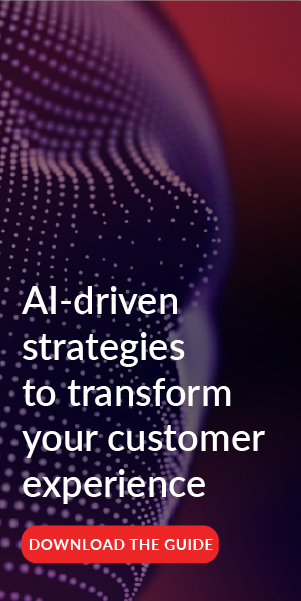Topics
Customers Hate Repeating Themselves. They Shouldn’t Have To.

If there’s anything a customer hates, it’s when a company disrespects their time.
There are many ways this can happen. But in customer experience (CX) interactions, one of the most frustrating things a company can do is make customers repeat information they already provided.
Zoom’s research found that many brands are struggling to meet customer expectations in some of the most crucial areas of CX, like the length of wait times and ease of communication with customer service channels.
Customers know there’s a better way—and they don’t understand why they aren’t getting it. It tests their patience and leaves them feeling undervalued. And that’s when they’ll start thinking about taking their business elsewhere.
The root of the issue is that customers must often interact through multiple channels, and at each step they have to repeat what they’ve already said or inputted. Businesses need an omnichannel strategy, or a means to integrate multiple channels like email, chat, and phone into a cohesive experience.
Customer loyalty is hard to win. Don’t lose your customers because of a subpar service experience. Keep them happy with an omnichannel approach to customer service.
Today’s customer service landscape
Many customer journeys start simply. Maybe they send an email, then switch to a chatbot for quicker responses, only to find themselves on the phone with a representative later—something they were likely hoping to avoid.
These multiple touchpoints are extremely common in the average customer journey. According to Zendesk, the average customer service inquiry spans three channels. That’s not always an issue; having access to these channels is often a net positive for CX since different types of customers prefer to resolve their inquiries through different channels.
The problem stems from a lack of omnichannel integration. This means that many contact center agents don’t have the needed context and data from previous customer interactions. When agents lack that context, they necessarily ask questions. Giving the answers means that customers must repeat themselves, prompting both frustration and longer resolution times, each denigrating the customer experience.
Deloitte Digital’s 2023 Global Contact Center Survey reveals how bad the problem is. Only 7% of contact centers they surveyed had ways to seamlessly transition their customers between channels while preserving interaction data and context.
This service gap is not just a minor inconvenience; it’s a glaring flaw in the customer experience. Customers expect a fluid journey. A disjointed experience undermines their trust in a brand and makes them reevaluate whether doing business with that brand is worth it in the future.
The frustration doesn’t stop there
We’ve identified the top five frustrations customers experience during service interactions:
- having to repeat information, especially when switching channels;
- the time it takes for service teams to respond;
- the length of time it takes to resolve issues;
- inconsistent service quality across channels; and
- lack of visibility into the service process.
Omnichannel support is the answer to many of these frustrations, which makes these issues even more infuriating to customers. They’re well aware that the technology to create a cross-channel experience is available. So, why should they ever leave a CX interaction feeling like they contacted five different businesses instead of one?
The psychological impact of poor service experiences can linger long after an interaction has ended, and customers share their frustrations with others. This, in turn, can damage a brand’s reputation. As businesses strive to improve customer support, addressing these frustrations is essential for maintaining a loyal customer base.
These impacts are well documented. Microsoft’s Global State of Customer Service Sophistication report reveals that globally, 96 percent of customers will leave without warning due to poor customer service.
Consistent slip-ups in CX could cause you to lose over half your business. You need a reliable solution, because without good customer service, there’s no trust. And without trust, there’s no customer base.
The power of omnichannel communication
A practical omnichannel customer experience ensures that customers receive personalized service however they engage. Improve your company’s CX by investing in technology that enables seamless contact center channel switching.
This approach enhances customer satisfaction and empowers agents to provide more efficient service. For example, if a customer starts a chat and later calls in, the agent should have easy access to the chat history, allowing for a smoother transition and quicker resolution.
Tech for a seamless omnichannel experience
New technology, including AI and machine learning, facilitates better omnichannel communication. Business leaders are recognizing just how valuable these features are. McKinsey has noted an uptick in companies prioritizing investment in AI, including in areas like:
- customer self-service bots;
- customer intelligence from conversations;
- customer experience hyperpersonalization;
- contextual searching and query processing;
- automated post-call summaries; and
- realtime agent assistance or copiloting.
Investing in this kind of tech creates a smoother and more cohesive customer journey. Businesses can leverage technology to ensure that customers are better off after an interaction with their CX team. Some tech-based solutions for omnichannel support include:
- Customer relationship management (CRM) systems: these systems help manage customer interactions and data, providing a central location to access customer information quickly.
- AI and machine learning: these technologies can analyze data to provide insights and improve service delivery to better anticipate customer needs.
- Integration of communication channels: ensuring that all channels are interconnected allows for smoother transitions and better customer experiences, reducing customers' likelihood of repeating themselves.
AI is particularly beneficial because it can help summarize customer interactions in real time. This is one of the most effective ways to avoid making customers repeat themselves. The agent gets all the information they need based on a previous channel interaction, and the customer feels heard and valued at every step in their journey.
CX Today’s review of Google Contact Center AI covers much ground on this topic, highlighting the advantages of using AI and machine learning in CX environments. An interesting benefit they mention involves agent satisfaction.
They state that Google’s CCAI “doesn’t just improve the customer experience; it also empowers and supports agents. Team members can accomplish more with predictive AI-driven routing.”
The value-add associated with implementing this technology must be underscored because recruiting the right agents and aiding them in being the best brand ambassadors they can be is a perennial challenge. AI-assisted agents can enjoy smoother, less tense exchanges with your customers by helping them avoid the dreaded need to repeat themselves. This means both the customer and the agent leave the interaction more satisfied.
Improving agent action through tech-supported omnichannel integration has lasting effects on every aspect of your business. The value of this technology is only growing, and its benefits often echo across a company’s customer service experience.
Best practices for implementation
If you want to implement omnichannel support, there are a few steps you should follow to ensure you do it right.
- Assess current customer service channels: identify gaps and areas for improvement, ensuring effective integration of all channels.
- Invest in technology solutions: choose solutions that facilitate simple transitions between channels, enabling agents to access comprehensive customer histories.
- Train staff: emphasize the importance of a smooth customer journey and effective communication, ensuring that all team members understand the value of this approach to service.
- Continuously monitor and improve: regularly evaluate the effectiveness of your omnichannel strategy, gather customer feedback, and make necessary adjustments.
Automating your contact center with omnichannel support should always serve one purpose: ensuring your customers feel cared for and understood, regardless of which channel they use to communicate with your business.
Don’t repeat the same mistakes; invest in omnichannel CX
No one wants to repeat themselves. Time is too valuable, and ignoring the value of your customer’s time is a mistake you may not get to make twice.
The benefits of an omnichannel strategy go beyond providing convenience. They also demonstrate that you understand your customers’ needs and preferences. If your customers feel they’re getting a personalized, seamless experience, they’re more likely to remain loyal and recommend you to others.
Provide your customers with the support they want and deserve. Act now to elevate your customer service to meet customer expectations. If you don’t, a competitor will, and you can be sure that today’s customers will notice.
Download "How AI should enhance your customer experience in 2025: A guide to finding the right BPO innovation partner" to learn more about how these innovations are enhancing the customer experience.


